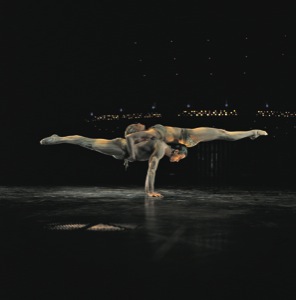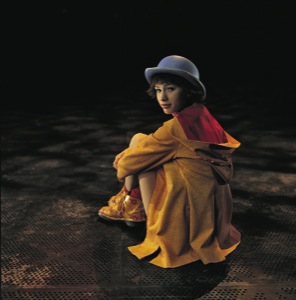
“What’s gay about the show? What isn’t gay about the show?” answered Jamieson Lindenburg.
Young Zoé, John, the Target, the Aviator and Boum-Boum return to San Diego as Cirque du Soleil presents the touring production of Quidam. The beloved characters have dazzled audiences since its world premiere almost 15 years ago. Bridging together their stories through song is Lindenburg, performing as lead singer.
As the unofficial gay ambassador of Cirque du Soleil – “I’m not sure how I got that title,” he joked – Lindenburg took some time between recent performances to speak with San Diego LGBT Weekly to discuss how the show is changing and evolving with the times, while still remaining true to its original – and gay – tale.
Along with an international cast of 52 world-class acrobats, musicians and singers, this production has toured five continents and has been experienced by millions of people. After several years abroad, Quidam returns to North America where it embarks on a new journey, now performing the same captivating production in arenas.
“It’s made the transition from the chapiteau, which is the big top tent, to the arena,” Lindenburg said, adding it’s a significant change for Quidam, allowing the tour to play in places it has never been before.
For example, the chapiteau has a maximum capacity of 2,500, while the Valley View Casino Center (where the show performs in San Diego) can accommodate up to 13,000 when configured for a circus. Lindenburg said that’s a unique trade off. “It’s a giant arena, so you lose some of the intimacy that you would normally see in the chapiteau. But when it’s a full house, it’s just incredible.”
Over the years, he has seen the show develop and grow, with new acts, different performers and now a larger performance space. Throughout the progression of the show’s life, he said the story is the same. The story of young Zoé.
In the Quidam tale, young Zoé is bored. Her parents, distant and apathetic, ignore her. Her life has lost all meaning. Seeking to fill the void of her existence, she slides into an imaginary world where she meets characters who encourage her to free her soul.
“The general story is of a girl, Zoé, and the universe she creates in her head, and all the characters that come alive,” Lindenburg said.
Unlike any other Cirque du Soleil show, Quidam does not take spectators to an imaginary realm of fanciful, larger-than-life characters. Rather, it is an examination of our own world, inhabited by real people with real-life concerns.
“It’s one of the first shows that touches on humanistic qualities,” Lindenburg explained. “The Cirque du Soleil shows before were all crazy worlds with colors and imaginary characters. This is one of the first that deals with real human emotions and situations.

“It’s a darker show, too,” he continued, saying the topics are just as intense as they are beautiful. “I think some of the big things that it touches on would be divorce and mass destruction and some other world issues.”
It was a risky gamble, he said, for Cirque to tackle such serious topics in a circus atmosphere. Would the show be accepted as widely as previous productions? Or would audiences turn away from such somber subject matters.
The fact the show has lasted for almost 15 years answers those questions. Lindenburg continued to explain that, because of Cirque du Soleil’s wildly imaginative production system, anyone can create their own interpretation of the show’s storyline.
“It’s up to your imagination as a spectator,” he revealed. “There is a general story, but it’s up to your interpretation of what you think the story is, what metaphors, and what through lines you pick up on and view as the audience.
“There are so many beautiful things to watch,” he continued. “I have seen more than 500 shows, and I still notice things I have not seen before. What does that mean? I don’t know. What do you think it means? They always challenge your mind and your imagination.”
That imagination to create make believe worlds is what has drawn a strong LGBT following.
“What attracts the gay audience is losing ourselves in a fantasy world. It is the same reason I think we like the Wizard of Oz,” Lindenburg said. “I don’t know if that has to do with turmoil, or has to do with us trying to forget what we are facing, especially in society right now; in our community, we are trying to forget how hard things can be for us. So, we like to lose ourselves in these fantasy worlds.
“Cirque du Soleil creates these incredible, artistic, beautiful things on stage. A lot of the gay community attached themselves to Cirque du Soleil a long time ago, and that’s a big part of why it is what it is today.”
Lindenburg admits, in a more casual manner, Quidam also provides a raw attraction for the LGBT audience. After all, there are some extremely well-built performers in very tight-fitting costumes.
“Let me tell you,” he said, in a very catty tone, “we just got a heap of Romanian and Russian boys for the Banquine number. It’s the finale of the show, where they create crazy acrobatics using their bodies. Having some hot, young, Euro blood on the stage is the gayest thing I can think of. I enjoy watching it every night.”
Whatever attracts you to Cirque du Soleil – and however you interpret Zoé’s tale – don’t miss the opportunity to see Quidam. Tickets are available now at cirquedusoleil.com/quidam or call 800-745-3000.

‘Quidam’ facts
There are approximately 250 costumes, 500 costume accessories and 200 to 300 shoes in Quidam.
Quidam is the first show to use everyday clothing – though adapted – in its acrobatic acts. The broken colors used for the costumes, from blue to pink tones, create a dramatic effect and add to the show’s gloomy overall atmosphere.
The set’s arch (also known as the téléphérique) is constructed of five all-aluminum rails for an overall length of 120 feet. Each rail of the téléphérique houses two trolleys that run from one end of the structure to the other. One is used to transport performers and acrobatic equipment and the other raises or lowers them to the appropriate height and position for the particular act.
The stage floor is made of aluminum decks with a rubber-type mat. The rubber has more than 200,000 perforations to allow light to pass through from below, thus creating special visual effects.
The music is performed live at every show by six musicians playing a wide variety of instruments. In Quidam, Cirque du Soleil takes a new approach to vocals. For the first time, the fragility of a child’s voice (young Zoé) combines with the strength of a man’s voice (performed by Jamieson Lindenburg) to create a powerful blend of sensitivity and intensity.
There are 30 hats in Quidam including the bowler hat of the Quidam character which Zoé uses to enter the magical world.
In 1984, 73 people worked for Cirque du Soleil. Today, the business has 5,000 employees worldwide, including more than 1,200 artists.
The average age of employees is 37.
The company’s employees and artists represent close to 50 nationalities and speak 25 different languages.
In 2010, Cirque du Soleil presented 20 different shows around the world.

Quidam is the fourth show to be converted to an arena. The other shows include Saltimbanco, Alegria and Dralion.
There are seven Cirque du Soleil shows performing in Las Vegas.
Cirque du Soleil has several shows highlighting famous musicians, including The Beatles, Elvis and the soon-to-be-staged Michael Jackson.
There are 20 wigs used in Quidam, which are made from natural and synthetic hair and are styled for every show.











